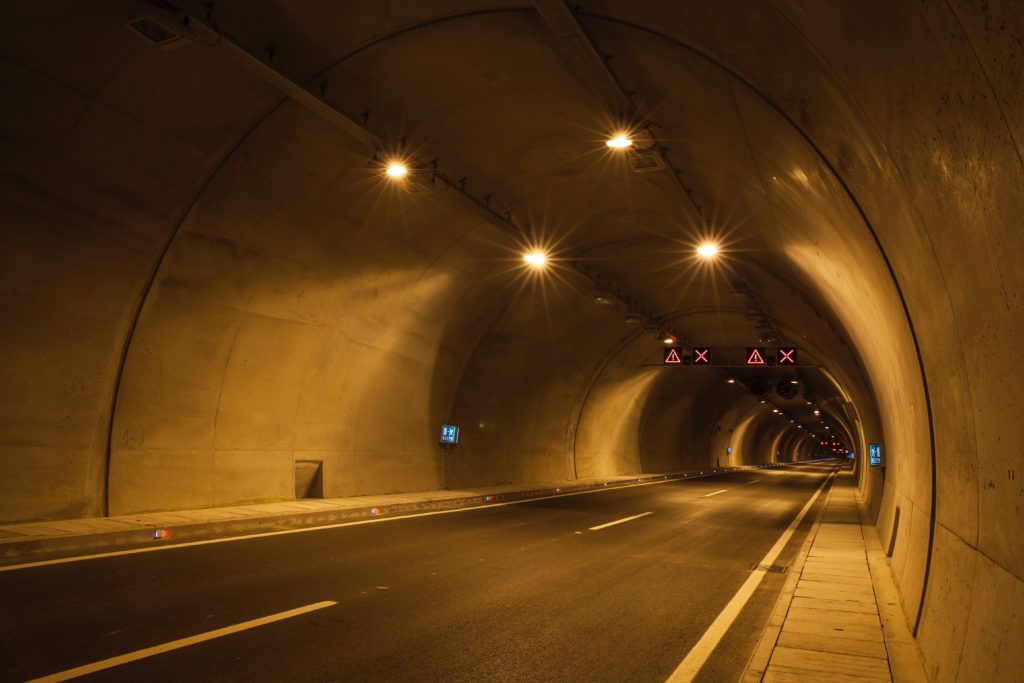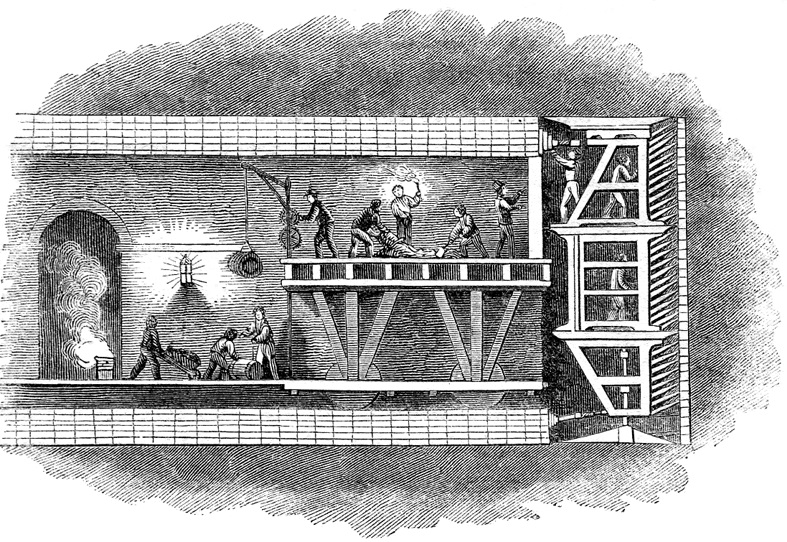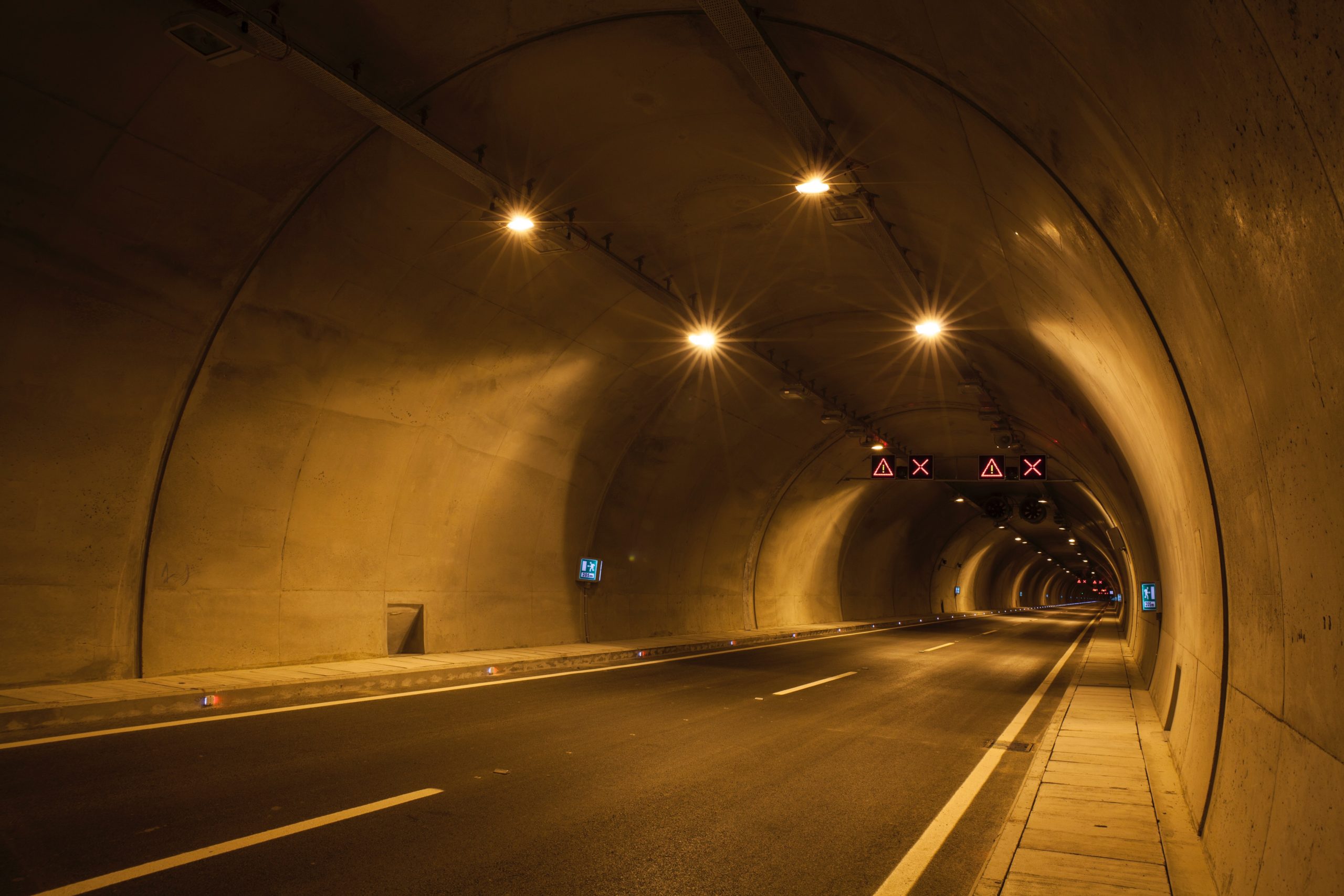
How do you build a tunnel underwater? You can either build the tunnel above ground in pieces and lower it into the water, or you can dig the tunnel underground.
Humans have been making tunnels for thousands of years. The art of tunneling probably started when prehistoric people wanted to make their caves bigger. Different civilizations developed tunnels for different purposes. The Babylonians used tunnels for irrigation in 2000 BC. The Egyptians dug temple rooms in rock cliffs. They used copper saws and reed drills to do it. The ancient Greeks and Romans used tunnels to drain marches. The Romans dug tunnels for aqueducts. They dug a 1.5 km tunnel in 36 BC to carry water.
The first tunnel blasted out of rock by gunpowder was constructed in France in 1681. However, most tunnels to this point were for irrigation, or for sewers, or as small passageways, or as underground rooms. There was no need for tunnels for people as we imagine them now. People traveled by horse or walked and if there was a mountain, they went over it or round it. If there was a river, they took a boat or a bridge over it. People wouldn’t have thought that tunneling was necessary, even if it was possible, because there was no need to go straight. It is only with the invention of modern modes of transport that the advantages of being able to go through a mountain outweigh the effort required to tunnel through it.
The 1681 tunnel blasted out by gunpowder in France was a tunnel for a canal. It was 156 m long and it linked the Atlantic and the Mediterranean. Obviously, it is easier to use if a canal is flat. Otherwise you have to make locks, which are a whole other problem. The canal was made by putting gunpowder in holes drilled with handheld iron drills. After this, more canal tunnels were built and they were used to carry goods, especially coal. Canals and canal tunnel’s continued to flourish until the invention of the railroad.
The first railroad tunnel was built in 1793 in Fritchley, England. It was built for a horse-drawn rail carriage. The first tunnel built underwater was the Thames tunnel built between 1825 and 1843 by Marc Isambard Brunel. It was 400 m long and was about 23 m deep. It ran under the River Thames and was originally built for horse-drawn carriages but it became a pedestrian tunnel. It was converted into a railway tunnel in 1869.

Other people had tried to dig tunnels under the river, but they had failed and the tunnels flooded each time. Many people thought it was impossible to build a tunnel under water. Brunel came up with something called the tunneling shield. It was a temporary support structure that would hold up the tunnel while it was being excavated. This technological innovation made it possible to dig tunnels under a river. The tunnelling shield has a strong wooden frame and moveable iron plates at the top. It has spaces within for people to stand and dig. It holds the soft earth under the water up and it lets the men dig the tunnel. The tunnelling shield is moved forward at the speed the men dig the tunnel and proper supports are put in as they go.
As an aside, there is a legend that a tunnel was built under the River Euphrates in Babylonia in about 2180 BC. The tunnel was supposed to be 900 m long and connected the royal palace and a temple. Instead of tunneling under the river, the river was diverted until construction was completed. However, there is no actual evidence for this tunnel.
So, how do you build a tunnel under water? You can dig them through the earth, or you can assemble them on the surface and then lower them. The earliest types of tunnels were all dug deep in the earth. The deeper the tunnel is below the waterbed, the easier it is to protect it from flooding or collapse. Tunnelling shields are still used, but they are far more advanced than the ones Brunel made. These days there are automated Tunnel Boring Machines (TBM) that do all of the work. They have a cutting head at the font and scoops to drop the rock and earth onto a conveyor belt. There is an erector behind the cutting head that puts up the tunnel lining as the TBM digs through. These machines can even be remotely operated, so very few people have to be in the tunnel. This is probably best because compressed air is used to keep water from leaking into the tunnel and that can cause compression sickness.
The second way is to build the tunnel in pieces on the surface and submerge them. These are called Immersed Tube Tunnels. This is the more common method these days. They were invented in the early 1900s. Immersed tube tunnels are usually made from steel and concrete. All of the necessary parts are preinstalled, and the tunnel parts are sealed at both ends to keep the water out. A boat carries them out to the right position, and they are sunk to the bottom into a trench lined with gravel. There are rubber seals between each piece to make a watertight seal and divers weld the parts together. A layer of gravel about 2m thick is layered over the tunnel to protect it and then the seals between the pieces are removed. Immersed Tube Tunnels are the most common kind of tunnel these days because they are far cheaper than Tunnel boring machines and they are easier and safer. And this is what I learned today.
Sources:
https://science.howstuffworks.com/engineering/structural/build-underwater-tunnel.htm
https://en.wikipedia.org/wiki/Tunnel
https://www.bbc.com/news/uk-england-derbyshire-22342239
https://www.britannica.com/technology/tunnel
https://en.wikipedia.org/wiki/Euphrates_Tunnel
https://en.wikipedia.org/wiki/Fritchley_Tunnel
https://en.wikipedia.org/wiki/Thames_Tunnel
https://en.wikipedia.org/wiki/Tunnelling_shield

